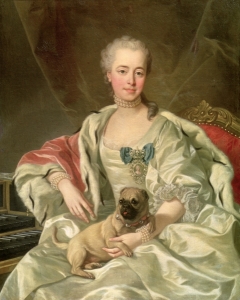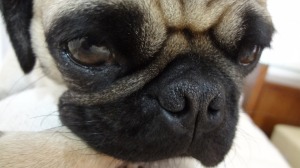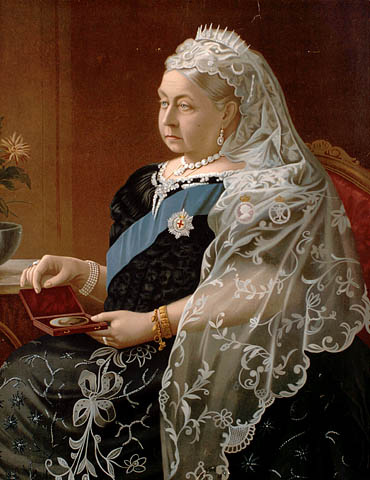“Much in little” or “a lot of dog in a small space” describes our little wrinkly fluffybutts, the Pugs. These are dogs that are very easy keepers. Docile and gentle, Pugs were bred specifically to be lap dogs and companions. Some other names for this little guy include, Chinese Pug, Dutch Bulldog, Dutch Mastiff, Mini Mastiff, Mops, and Carlin.
The Chinese were said to have prized these dogs because of the way the wrinkles on their foreheads resembled symbols of good luck. Pugs with wrinkles that seemed to form the word “prince” in Chinese were especially prized. Pugs have been companions to Emperors, Kings, Queens, Princes, Princesses, and the monks of Tibetan monasteries.

Pugs are basically the class clowns. They are playful and love being the center of attention. They enjoy delighting their owners with silly antics and cute faces. Being ignored by their people or person can cause depression. They need the attention and affection of their owners to be happy.
Though they can be energetic in play, they do not require a lot of exercise. Just a couple strolls a day will do. They much prefer to just sit in their person’s lap or lie by their feet. This sedentary lifestyle can cause them to become obese. As such, their food intake should be monitored closely and treats kept to a minimum.
Pugs are ideal for apartment living, and not only because they don’t need a lot of exercise. Pugs are also not barkers. They are quiet companions, though they may bark a little bit when a stranger comes to the door. They do, however, shed quite profusely. Though their coat is short and thin, it is a double coat and will shed heavily year-round. So if you plan to purchase or adopt a Pug, you may want to invest in a good vacuum!
Their wrinkles, if deep, may need cleaned and dried a few times a month to prevent bacterial and yeast infections. They must also be thoroughly dried after a bath as moisture can then become trapped and become a breeding ground for infection.
Most Pugs love children and can play with them with little risk of getting hurt with their stout little bodies. Pugs tend to be sensitive to the moods of their people and are eager to please them. If the children want to run around and play, the Pug might just join in. If the children want to go down for a nap, well, that’s just fine with the Pug, too! In fact, many Pugs are lazy and nap often. They also snore, a habit most Pug owners find adorable, though others may find it obnoxious.
Pugs come in two distinct colors – fawn and black. The fawn Pug has a couple variations known as silver fawn and apricot fawn. Both colors are accepted in the show ring.
Unlike the Pugs of today, ancient Pugs had longer legs and a somewhat longer muzzle. The shorter muzzle of modern day Pugs can present a problem. How, you ask? The compact airways can make breathing difficult for these stout little dogs. It also makes internal temperature control difficult, especially in hot and humid climates. For this reason, Pugs should be kept primarily indoors. Again I ask, why are we breeding for looks rather than for the health and happiness of our canine companions? Would it kill breeders to find a way to breed for a muzzle that’s not quite so squished to help prevent the breathing problems Pugs experience throughout their lives? How comfortable could it be wheezing and huffing all the time?

In any case, there are a few health issues that come along with that short, squished muzzle. Like many other breeds with squished faces, Pugs have an elongated palate. When Pugs get excited, they will sometimes start what is called “reverse sneezing,” also known as pharyngeal gag reflex. I’ve only recently heard of this myself. A reverse sneeze is when fluid or debris gets caught under the palate and irritates the throat and limits their breathing. These episodes aren’t often harmful and can be helped by massaging the Pug’s throat or pinching their nose shut so they have to breathe through their mouth.
Some Pugs are also born with pinched nostrils, or stenotic nares. In severe cases it can inhibit their breathing and put pressure on their larynx. Dogs with these severe cases of stenotic nares may pass out from blocked airways. Should this happen, one should ask their vet if surgery is needed.
The most serious problems one may encounter should one purchase or adopt a purebred or even mixed breed Pug are PDE or Pug Dog Encephalitis, which is an inflammation of the brain and meninges, and hemivertibrae when two parts of a spinal vertebrae don’t fuse properly when the Pug is growing. PDE is a genetic disease that occurs between the ages of 6 months and 7 years of age. Dogs that have PDE usually die or have to be put to sleep shortly after onset. Hemivertibrae creates an irregularly shaped spinal cavity that may put pressure on the spinal cord and can result in paralysis.
If you are interested in purchasing or adopting a Pug, please do your research. Though they are generally easy keepers, there are health issues one should be aware of before getting a Pug. Also, they may not be right for someone who hates a lot of shedding or can’t stand snoring, snorting, wheezing, or breathing that sounds like a diesel engine. However, if you are looking for a laid-back dog who likes to cuddle and follow you around like a shadow, who snores as loud as you do, and whose goal in life is to make you smile, a Pug might just be the pet for you!

Fun Fact: Queen Victoria’s passion for Pugs helped them flourish in 19th century England, and that passion was passed down to other members of the Royal family, such as her grandson, King George V, and his son, King Edward VIII.
Do you or have you owned a Pug? Please tell us about him/her in the comments below! I’d love to hear about your experiences with the breed.
Have suggestions? Comment below!
Have a breed you’d like to see featured in our next Breed of the Week? Leave your suggestion in the comments below!
If you liked this post, please consider becoming a part of our Fluffybutt Family by liking, sharing, and/or following our blog. We’d love to share our journey with you!









Very informative post! 🙂 I’ve grown up with pugs and you mentioned a few things I didn’t even know about. It was a great read, so thank you for sharing all that great information. 😀
Pugs are so lovable. ❤
LikeLike
Thank you! I’m glad to provide new information 😁 I’ve never had a pug, but I do find them super adorable ❤ Especially their wrinkly little faces!
LikeLiked by 1 person